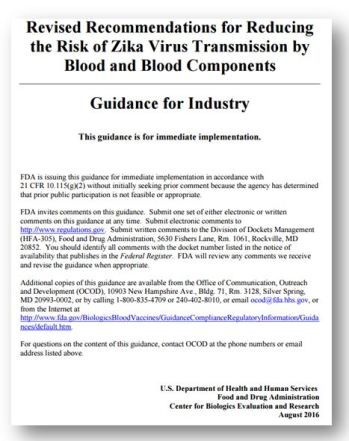FDA Guidances: Zika, Device Benefit-Risk, Device Patient Preference, Antibacterial Drugs
FDA BRIEF: Week of August 22, 2016

UNIVERSAL TESTING of donated Whole Blood and blood components for Zika virus in the U.S. and its territories.
ZIKV IDENTIFICATION
- Transfusion-Transmitted Infection (TTI) under 21 CFR 630.3(1)
- Relevant Transfusion-Transmitted Infection (RTTI) under 21 CFR 630.3(h)(2).
Determination based on
- severity of disease
- risk of transfusion-transmission by blood and blood components
- availability of appropriate screening measures
- significant incidence and prevalence affecting the potential donor population
RECOMMENDATIONS
- Testing and Pathogen Reduction
- Donor and Product Management
- Labeling of Whole Blood and Blood Components Intended for Transfusion
PRINCIPAL FDA FACTORS for benefit-risk determinations for PMA and De Novo
STATUTORY Standards
- RASE- Reasonable Assurance of Safety and Effectiveness
- De Novo devices : May not need to confer as substantial a benefit; should sufficiently explain risks-benefits; risks appropriately mitigated by general and/or special controls
SCIENTIFIC EVIDENCE
- Clinical: Randomized, well-controlled, in target population
- Non-Clinical: Performance testing for safety/reliability/characterization, human factors and usability engineering, animal, cell-based studies
BENEFIT ASSESSMENT
- Type, Magnitude, Probability, Duration
RISK ASSESSMENT
- Severity, type, number, rate,probability, duration,
ADDITIONAL FACTORS:
- Uncertainty, Disease characterization, Patient-Centric assessments, Patient Preference, Availability of alternative treatments, Risk Mitigation, Poatmarket data. Novel Technology, Unmet Need
WORKSHEETS and EXAMPLES provided

PATIENT PREFERENCE INFORMATION (PPI) can provide a unique and important perspective on benefits-risks of certain medical devices; part of FDA’s Partner with Patients CDRH 2016-2017 Strategic Priority.
- Definition: Qualitative/Quantitative assessments of relative desirability or acceptability to patients of specified alternatives or choices …
- Estimates of how much different outcomes valued by patients vs. tradeoffs
- Only for certain devices : Direct patient interface, yield significant health and appearance benefits, treat a rare disease, novel technology
GUIDANCE OUTLINES:
- Voluntary submission for PMA, HDE, De Novo pathways –
- Linking to new Benefit-Risk guidance (described above)- PPI part of totality of evidence from clinical and nonclinical testing
- Quantitative Methods : Stated preference, Revealed preference
- Recommended Study Qualities : Patient Centeredness, Generalizability, Heterogeneity, Good Research Practices, Benefit/Harm/Risk/Uncertainty Communication, Cognitive Bias, Relevance, Robustness of Analysis, Study Conduct, Comprehension by Study Participants:
- Additional Considerations: Integrity, Conditions of Approval
- FDA Engagement and Submission: Pre-Submission meeting discyussion, Labeling
EXAMPLES are provided

ANTIBACTERIAL DRUG DEVELOPMENT and development, analysis, and presentation of microbiology data
EARLY DEVELOPMENT/NONCLINICAL
- Antibacterial Spectrum of Activity
- Mechanism of Action
- Intracellular Antimicrobial Concentration Assessment
- Resistance Studies
- In Vitro Antimicrobial Susceptibility Test Methods During Drug Development
EARLY CLINICAL DEVELOPMENT
- Provisional Antibacterial Susceptibility Test Interpretive Criteria
- Establishing In Vitro Antibacterial Susceptibility Test Interpretive Criteria
- Quality Control Parameters
OTHER
- First and Second Lists of Target Bacteria in Labeling
- Antibacterial Interactions and Fixed Combination Studies
- Additional Nonclinical Studies of Antibacterial Drugs
- Animal Models of Infection
- Microbiology Information Collected in Clinical Trials
- Electronic Submission of Microbiology Information
- Postmarketing Microbiology Information

